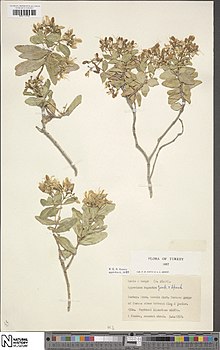Hypericum rupestre
| Hypericum rupestre | |
|---|---|

| |
| Specimen of Hypericum rupestre | |
| Scientific classification | |
| Kingdom: | Plantae |
| Clade: | Tracheophytes |
| Clade: | Angiosperms |
| Clade: | Eudicots |
| Clade: | Rosids |
| Order: | Malpighiales |
| Family: | Hypericaceae |
| Genus: | Hypericum |
| Section: | Hypericum sect. Arthrophyllum |
| Species: | H. rupestre
|
| Binomial name | |
| Hypericum rupestre | |
| Synonyms | |
| |
Hypericum rupestre is a species of flowering plant in the genus Hypericum. It is the type species of sect. Arthrophyllum. It was first described by Hippolyte Jaubert and Édouard Spach in 1842 in the journal Ill. Pl. Orient.. The species is found only in a small area in the southern region of Turkey.[1]
Description[edit]
The species is a shrub that grows up to 30 centimeters in height. It stands erect and is a bushy, rounded shape with erect or tortuous branches. The stems are 4-lined and are green when young, but later become red-brown and flattened, and still later turn grey. The species has 9-16 flowers that usually grow from two nodes. The flowers are 2-2.5 centimeters in diameter with elliptic and rounded buds, and their petals are bright yellow. It has 30-40 stamens, 3 ovaries, and 3-4 times as many styles as ovaries.[2]
Uses[edit]
H. rupestre, alongside several other species, is used as a traditional folk medicine in its native country, Turkey. Because of this, it has been investigated for its antibacterial properties, and ethanols extracted from it have been shown to be effective antimicrobials against Staphylococcus aureus and Bordatella bronchiseptica.[3]
| Plant Tested | Aqueous extract | Ethanol extract | ||
|---|---|---|---|---|
| MIC | MBC | MIC | MBC | |
| Hypericum rupestre | 1.6–6.3 mg/mL | 3.2–25 mg/mL | 0.8–3.2 mg/mL | 1.6–12.5 mg/mL |
References[edit]
- ^ "Hypericum rupestre Jaub. & Spach | Plants of the World Online | Kew Science". Plants of the World Online. Retrieved 2019-04-30.
- ^ "Nomenclature | Hypericum online". hypericum.myspecies.info. Retrieved 2019-04-30.
- ^ Dulger, B.; Hacioglu, N. (2009). "Antibacterial Activity of Three EndemicHypericumSpecies used in Folkloric Medicine against Methicilin-ResistantStaphylococcus Aureus". Biotechnology & Biotechnological Equipment. 23 (sup1): 763–765. doi:10.1080/13102818.2009.10818535. ISSN 1310-2818.

